
The green blotched moth is a moth of the family Noctuidae. It is found in New South Wales, Norfolk Island, Queensland, South Australia, Victoria, Western Australia and New Zealand.

Austramathes is a genus of moths of the family Noctuidae. It is endemic to New Zealand.
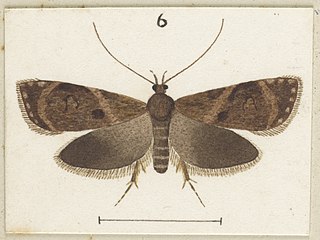
Izatha austera is a species of moth in the family Oecophoridae. It is endemic to New Zealand. The larvae of this species feed on dead wood by tunnelling into branches of its host species. The larvae matures from September and is on the wing in the months of December to January. The adult moth is variable in colouration but is seldom observed.

Physetica prionistis is a moth of the family Noctuidae. It was described by Edward Meyrick in 1887. It is endemic to New Zealand and is widespread throughout the North, South and Chatham Islands. This species can be found in open clearings of shrubland and forest at altitudes from sea level up to the alpine zone. Adults are on the wing throughout the year and are attracted to sugar traps and occasionally to light. The life history of this species is unknown as are the larval host species.

Ichneutica nullifera is a moth of the family Noctuidae. This species is endemic to New Zealand and can be found in the Tongariro National Park, along the Wellington coast and throughout the South Island. The adults are large and the forewing of adults can vary in colour from pale fawn to dark grey. The larvae are coloured a bright yellow-brown with a paler underside. The larval host species are in the genus Aciphylla and as a result the adult moths are often found in habitat dominated by species in this genus. Adults are on the wing from November to early April and are sometimes attracted to light.
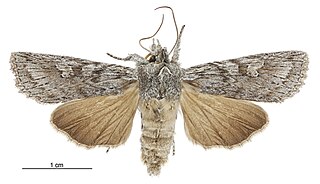
Physetica phricias is a moth of the family Noctuidae. It is endemic to New Zealand. It is wide spread in the South Island and inhabits shrubland. The host of the larvae of this species is matagouri. The adult moths are on the wing from September to May and July, and are attracted both to light and sugar traps.They are a faster-flying species and remain active even during windy conditions. P. phricias can be confused with some forms of P. sequens. However P. phricias can be distinguished as it has a less marbled appearance to its forewing.

Ichneutica atristriga is a moth of the family Noctuidae. It is endemic to New Zealand and is found through out the North, South and Stewart Islands. The larval hosts likely include tussock grasses included Poa cita, P. colensoi and Festuca novae-zelandiae. Larvae have been reared on species in the genera Bromus and Festuca. The adults of this species are on the wing from November to May. I. atristriga can possibly be confused with the smaller species I. propria. However I. atristriga has thorax and forewings that have a pinkish tinge and I. propria has a dark streak on the discal part of the forewing which I. atristriga lacks. A study has indicated that the population numbers of this species have decreased.

Ichneutica steropastis, or the flax notcher moth, is a species of moth in the family Noctuidae. It is endemic to New Zealand and can be found throughout the country from the Three Kings Islands to Stewart Island as well as in the Chatham Islands. The larvae of this species feed on a variety of native and introduced plants however the New Zealand flax is one of the more well known host plants for the larvae of this moth. The larvae are nocturnal, hiding away in the base of the plants and coming out to feed at night. They create a distinctive notch in the leaf when they feed. The adults of this species are on the wing from October to March. Although adult specimens of I. steropastis are relatively easy to recognise they might possibly be confused with I. inscripta, I. theobroma or with darker forms of I. arotis. However I. steropastis can be distinguished as it has a long dark basal forewing streak that these three species lack.
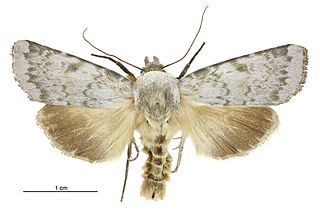
Physetica caerulea is a species of moth of the family Noctuidae. It is endemic to New Zealand and can be found from the centre of the North Island south, including the South and Stewart Islands. The adult moths are variable in appearance but can be distinguished by the bluish tinge to the forewings as well as the underside buff colour. However this species does have several forms including a very dark bluish black form, a brownish form and a green-brown form. It lives in open habitats and can be found in tussock grasslands and dunes and can normally be found from altitudes of sea level up to 900 m. Adults of this species are on the wing from August to April. As at 2017, the life history of is unknown as are the host species of its larvae. However it has been hypothesised that the larval host species is a tomentose plant.

Austramathes purpurea is a species of moth in the family Noctuidae. It is endemic to New Zealand and can be found throughout the North and South Islands but has yet to be recorded at Stewart Island. It inhabits native forest. This species might possibly be confused with A. pessota, however this latter species does not have the purple hue to the forewings. The larvae of A. purpurea feed primarily on māhoe but have been recorded as feeding on, and have been reared on, narrow-leaved māhoe. The larvae pupate in a silken cocoon on moss covered ground. Adults can be found on the wing during the months of March to January but mainly occur during New Zealand's late autumn, winter, and spring. Light trapping may not be the most efficient technique for collecting this species.
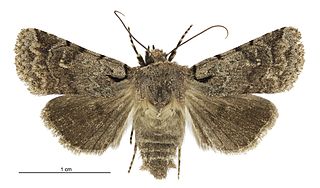
Austramathes fortis is a species of moth in the family Noctuidae. It is endemic to New Zealand and is found in both the North and the South Islands but has yet to be recorded at Stewart Island. It can be found in shrubland containing its host species at a range of altitudes from sea-level up to 1840 m. The larvae of this moth feed on several Melicytus species including M. crassifolius, M. alpinus, M. macrophyllus and M. novae-zelandiae. The larvae pupate in a cocoon of silk at the base of its host plant. It can take between 25 and 45 days before the adult moth emerges. Adults can be found on the wing during the months of July to March. The adults tend to be on the wing in twilight hours but have also been known to be active during the late afternoon. They are attracted to light but this behaviour may limit the number seen at light traps. The distinguishing feature of this moth is the curved black line at the base of its forewing. This species is unlikely to be confused with any other species in its range but it is very similar in appearance to A. squaliolus. However this latter species is only found on the Chatham Islands.

Austramathes pessota is a species of moth in the family Noctuidae. It is endemic to New Zealand and is found in Northland, in the southern North Island and in the South Island, mainly on the eastern side of that island but is also present in Fiordland. It is not regarded as being present in either Dunedin or the Southland district. This species lives in shrubland at altitudes ranging from sea-level up to subalpine. As at 2017, the larvae have yet to be described or photographed but it is known that they feed on Melicytus alpinus and it is likely that Melicytus micranthus is also a host. Adults of this species are distinctively patterned and coloured. Its appearance differs from its close relatives such as A. purpurea as it lacks the purple hue that can be seen on the latter species forewings. It also differs from A. coelacantha as it is much darker and has a distinctive small, round, pale mark on its forewing. Adults are on the wing from December to April.
Austramathes coelacantha is a species of moth in the family Noctuidae. It is endemic to New Zealand and is found in the central and east of the South Island. It lives in shrubland in inland areas as well as in Southern beech forest at subalpine altitudes. The life history of this species is unknown as are the host species of its larvae. However the larval host-plants may be species within the genus of Melicytus. Adult moths are on the wing during the months of January to March. They are attracted to light and appear to be active later in the evening, and not at twilight.
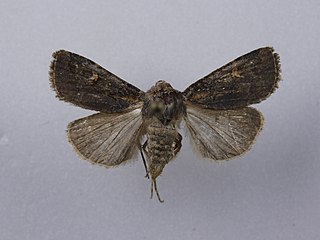
Proteuxoa tetronycha is a moth of the family Noctuidae. It is endemic, and can be found throughout, New Zealand. This species was previously muddled up with the rarer Proteuxoa comma and is very similar in appearance to that other species. P. tetronycha can be distinguished from P. comma by the paler colour of its prothorax as well as the browner base colour of its forewings. P. tetronycha is also a smaller moth with the wingspan of the adults of this species being between 29 and 33 mm. There are also differences between the females of these two species. For the females of P. tetronycha, their ovipositor is lacking the spiny hair like structures that are present on the ovipositor of P. comma. Larvae likely feed on a variety of host species and have been raised on Acaena species as well as Poa cita. The adults of this species are on the wing from September to March and are attracted to light.

Asaphodes chlorocapna is a species of moth in the family Geometridae. This species is endemic to New Zealand and can only be found in the Chatham Islands. The larvae of this species consume the leaves of Muehlenbeckia plants. Adults are on the wing in January. This species is classified as "At Risk, Relict'" by the Department of Conservation.
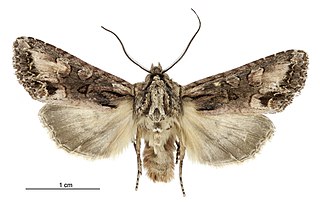
Ichneutica bromias is a moth of the family Noctuidae. This species is endemic to the Chatham Islands of New Zealand where is found on the Chatham, Pitt and Rangatira Islands. This species is similar in appearance to Ichneutica mutans but is darker and duller in its overall appearance. However, as I. mutans is not present in the Chathams this similarity is unlikely to cause confusion. The adults of the species are on the wing from November to March. The life history and the larval host species are unknown.
Ichneutica seducta is a moth of the family Noctuidae. This species is endemic to New Zealand. It is found only in the Chatham Islands and inhabits native forest. The life history of this species is unknown but the larval host species is likely to be Dracophyllum arboreum. The adults of this species are on the wing from November to January and are attracted to light.
Ichneutica thalassarche is a moth of the family Noctuidae. This species is endemic to New Zealand and is only found in the Chatham Islands. It has been collected at Chatham Island, Pitt Island and Rangatira Island. The life history of this species is unknown as are the host species of its larvae. The adults of this species are large with a pale grey throax and forewing. A diagnostic feature is the pattern on its forewing which is a white subterminal line joined by black "teeth" markings. This species has been recorded as a winter flyer having been collected in June to August.
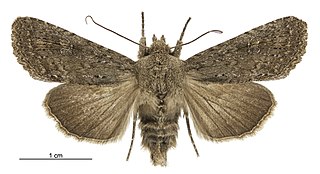
Physetica homoscia is a species of moth of the family Noctuidae. It is endemic to New Zealand and is found throughout New Zealand including in the Auckland Islands. This species inhabits places where its host plants are common and this includes costal dune habitat. It lives at a wide range of altitudes from sea-level up to at least 1750 m. The larvae of P. homoscia feed on Ozothamnus leptophyllus and Ozothamnus vauvilliersii. They are very active and drop to the ground when disturbed. Larvae are parasitised by a species of fly. This species pupates in the soil and the pupa life stage lasts for approximately 6 weeks. The adult moths are on the wing from September to June and are attracted to light. The adults of P. homoscia might possibly be confused with Ichneutica moderata however this latter species lacks the small white dots on the forewing veins of P. homoscia. Adults might also be confused with P. temperata but P. homoscia is significantly larger in size.
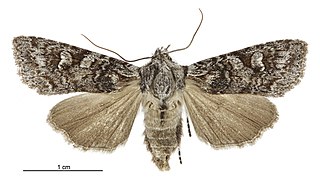
Physetica longstaffi is a species of moth of the family Noctuidae. It is endemic to New Zealand and found in the North and South Islands. This species lives in open habitats and shrublands, at altitudes ranging from the low alpine zone down to sea-level. As at 2017 the biology of this species is in need of further investigation as there is no published description of the larvae of this species nor have larval specimens been preserved in collections. There is also confusion over the possible larval host plants for this species. This species is on the wing from February to May. There is also a record from the North Cape in December. The adults of this species is attracted to light. P. longstaffi might possibly be confused with P. sequens or P. phricias. However unlike both P. sequens and P. phricias, P. longstaffi has a large oval mark near the centre of the forewing. Other distinguishing features include further differences in the colouration of the forewings of P. longstaffi as well as differences in the third labial palp segment of the male and differences in the shape of the male genitalia.

















